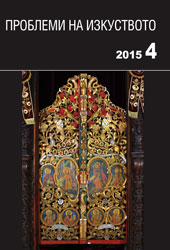Къде е византия в края на XVIII в.? Пъзел за изкуствоведи
Where is Byzantium at the End of the Eighteenth Century? Puzzle For Art Historians
Author(s): Emmanuel MoutafovSubject(s): History, Fine Arts / Performing Arts, Cultural history, Visual Arts, Modern Age, 16th Century, 17th Century, 18th Century
Published by: Институт за изследване на изкуствата, Българска академия на науките
Summary/Abstract: An icon of All Saints produced in 1771 was recently published in Bulgaria. It is owned by the National Archaeological museum in Sofia and comes from the region of Samokov. Its composition is not unknown to Orthodox iconography, but the signature of Zograph is of particular interest: α΄ ψ΄ α΄ Διά χειρός Κωνσταντίνου αμαρτωλού του Βυζαντίου.What could Byzantium be for a Greek artist from the end of the eighteenth century, when researchers call this period Post-Byzantine? Certainly Βυζάντιο in combination with the image of St Constantine the Great marks eighteenth-century Constantinople or Konstantinyie as the capital of the Ottoman Empire. even more puzzling is why the artist did not use the Greek name of the city or its Ottoman version. Arguably, the answer is to be sought in the sociopolitical situation in the empire and the eternal City in 1771. After a brief and critical presentation of the development of Christian Orthodox art between fifteenth and twentieth century the author notes another possible explanation of the icon’s appearance exactly in the region of Samokov. Prior to 1766-67, this ethnic Bulgarian territory belonged to the diocese of the Serbian church, or of the Patriarchate of Pec, and after the destruction of the latter, Samokov came under the jurisdiction of Constantinople. Thus, it cannot be ruled out that the icon had been brought over from the Ottoman capital as a symbol of the transition of the local metropolis to the rule of the Greek Patriarchate, which still considered itself as Byzantine, or more precisely, as a Byzantine institution functioning in the Ottoman Empire. The first arch-shepherd of Samokov ordained by Constantinople was Philotheos, who was elected in Kurucesme in April 1778. Despite his Bulgarian origin, he became a monk at Mount Athos, studied in Istanbul and served as a deacon at the Patriarchate. Before Philotheos took over, the Bishopric of Samokov had been ruled by Neophitos Joanovich, exiled in Silivria, who was elected by Ipek. Upon his arrival in Samokov, the new metropolitan Philotheos, probably as a political act, brought with him the icon painted by Constantine in 1771. More importantly, the artist who created the icon of All Saints believed that he still worked in the Orthodox tradition established in the Middle Ages and designated by western European scholars as Byzantine; he did not see himself as a satellite of a parallel visual world lost after the Fall of the multinational Eastern Orthodox Empire. Relying on a religious term, Christian Orthodox, to talk about a type of art with hardly any secular manifestations, instead of using an artificial political and economic designation such as Post-Byzantine art, would in addition prevent misunderstandings during contacts with experts from other fields.
Journal: Проблеми на изкуството
- Issue Year: 2015
- Issue No: 4
- Page Range: 3-8
- Page Count: 6
- Language: Bulgarian
- Content File-PDF

